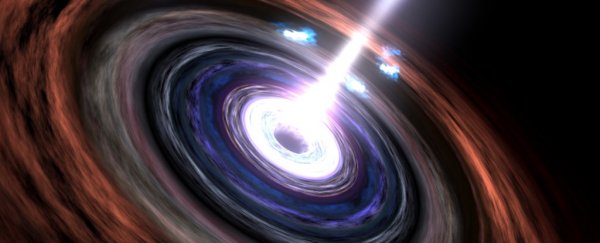Astronomers have discovered the existence of a supermassive black hole that looks to be the oldest and most distant of its kind we've ever encountered – and it just happens to be aiming its bright particle beam directly at Earth.
The newly found supermassive black hole – called PSO J030947.49+271757.31 – is the most distant blazar ever observed, researchers say. That conclusion is based on the wavelength signature of the object's redshift, a phenomenon scientists can use to measure the distance of light-emitting sources in space.
Blazars are supermassive black holes that lie at the heart of active galactic nuclei: central regions of galaxies bursting forth with high levels of luminosity and electromagnetic emissions, thought to occur due to the intense heat generated by particles of gas and dust swirling in the accretion disks of supermassive black holes.
Amongst these brilliant objects, blazars are the brightest of all – depending on your perspective, at least. The term 'blazar' is reserved for supermassive black holes where the jet of radiation is angled towards Earth, which makes it handy for astronomers to analyse these distant black holes in greater detail.
"The spectrum that appeared before our eyes confirmed first that PSO J0309+27 is actually an active galaxy nucleus, or a galaxy whose central nucleus is extremely bright due to the presence in its centre of a supermassive black hole fed by the gas and the stars it engulfs," says astrophysicist Silvia Belladitta from the University of Insubria in Italy.
"In addition, the data obtained by the Large Binocular Telescope (LBT) also confirmed that PSO J0309+27 is really far away from us, according to the shift of the colour of its light toward red or redshift with a record value of 6.1, never measured before for a similar object."
Based on their readings, astronomers say the light we can detect from PSO J0309+27 was actually emitted almost 13 billion years ago, meaning the blazar existed in the extremely early stages of the Universe, less than a billion years after the Big Bang.
While thousands of blazars have been found to date, the exceptional distance and age of PSO J0309+27 makes it a remarkable outlier – but that doesn't mean the object is entirely unique.
Because blazars happen to be pointed right at us, we have the opportunity to better analyse their beams. Similarly bright active galactic nuclei - called quasars - are inclined at different angles, so their particle beams are more likely to remain hidden from us.
"Observing a blazar is extremely important," Belladitta explains. "For every discovered source of this type, we know that there must be 100 similar, but most are oriented differently, and are therefore too weak to be seen directly."
This inferred population remains firmly hypothetical for now, but the discovery of PSO J0309+27, which the team estimates to have a mass equal to about 1 billion times the mass of the Sun, is a big deal. Having found PSO J0309+27, it tells us that these giant, powerful objects existed in the early stages of the Universe, and likely in great numbers.
The team acknowledges further observations are needed to narrow down just how sizeable this hypothetical black hole population might be. In any case, we're looking at an object that's big, important, and new to science; when you're studying supermassive black holes, no discovery is trifling.
"Thanks to our discovery, we are able to say that in the first billion years of life of the Universe, there existed a large number of very massive black holes emitting powerful relativistic jets," Belladitta says.
"This result places tight constraints on the theoretical models that try to explain the origin of these huge black holes in our Universe."
The findings are reported in Astronomy & Astrophysics.
